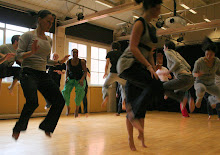Improvisation has allowed the creators of the piece to revisit body memory, drawing on techniques that were taught and demonstrated previously. The interaction between other characters has become an exchange of growth and development allowing the performer to learn more about their character and perhaps to their surprise, things they didn’t know. This in return, this permits room for new material and ideas to be explored. It seems to be a key ingredient for creating Porto as it spurs the creator to do rather than think. The Improvisation Game by Chris Johnston supports this by stating,
Improvisation is a research tool, widely used by artists from all disciplines. It’s a staple procedure in creating performance. While more cerebral exercises such as writing or composing allow for greater control over decisions, improvisation can be deliver the shock material. With its spontaneous, unpredictable processes, improvisation can deliver the right- brain gifts that sneak in under the radar. (p5)
With any research, it is a constant trial and error until something works, fits or makes sense. Johnston goes on to explain that without doing so performance cannot truly exist, and the benefits of working in this way is that impulses are constantly thrown into the creation. This has had a positive affect on Porto in the sense that individuals are no longer responsible for their own responses to the space but others too. It has become a communal understanding that we work as one ensemble, yet, aiding the piece with individual and unique interpretations. Reinforcing the idea that a community of people stand as one but individually stands alone.
The process of my character hasn’t really changed in comparison to the beginning of Porto and to the community she exists in. This is a reflection of her not fitting into the space or her community. There have been occasions where there were opportunities for interaction with others and it has been on her terms whether she accepts or declines. In this sense there has been a journey for her as she would not interact at all initially. The body language has become more open, but interestingly not to her community see seeks acceptance else where. The idea of wanting to belong often confuses her as she see’s others who seem to have the same problem, attempting to comfort, she stops her self from doing so as she knows this space isn’t for her. It’s as if the process is developing inside her waiting to explode due to this secretive and confined behavior.
The process of my character within Porto has determined the confined body language she communicates. Which feels acceptable as Miranda Tufnell and Chris Mickmay explain that, “Our bodies are the reflections of our lives: sitting walking, standing, we absorb the impact of each day. Each thought and sensation makes changes in the body.”(Body, Space, Image. London.1990. p.1) This quote began to make me think if I had no speech what kind of story would my body tell and made me question life within Porto, what marks, prints and scars can my character offer to Porto. The character takes up as little space when feeling vulnerable or unsure for example when sitting in the chair tries to curl into the chair. The position of the characters body is always internally expressed, and therefore doesn’t have an open torso or an up right head. Fidgeting with the hands, neck, face and clothes communicates nervousness. In terms where the body falls within the space, all effort is given internally and to gravity as she stands slumped to one side applying pressure to one leg with the spine curled towards the floor. Analyzing the approach of my characters expression I feel it has achieved the concept of Tufnell and Crickmay’s idea which is to
[…] let the sensation of thought dissolve through the body. Let the movement inside of the body – of breath, of thoughts – move outside. Allow the sensations their own time and expression – yawning, rolling resting - waiting for a space between the thoughts, an unlocking of parts of the body – gap into which something new can emerge. (p1)
Bibliography
Johnston.C; The Improvisation Game. London, Nick Hern Book Ltd, 2006
Tufnell.M & Crickmay.C; Body, Space, Image.London, Dance Books Ltd, 1990
skip to main |
skip to sidebar
Welcome to Porto2009.
This is the begining of our journey on the road of Porto2009. And the blog will give us the opportunity as a group to reflect on the work in which we have done within the sessions. We will keep you posted regarding the process we are making along the way.....
Enjoy.
Enjoy.



No comments:
Post a Comment